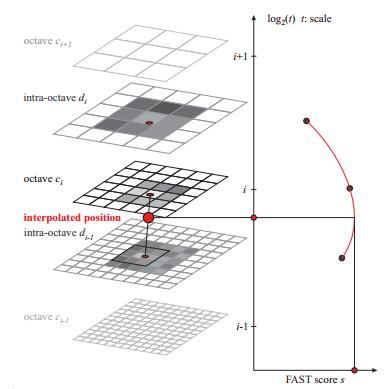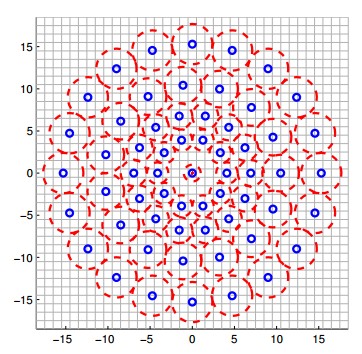图像特征描述子之BRISK
来源:互联网 发布:修图师需要学什么软件 编辑:程序博客网 时间:2024/05/22 14:10
原文站点:https://senitco.github.io/2017/07/12/image-feature-brisk/
BRISK(Binary Robust Invariant Scalable Keypoints)是BRIEF算法的一种改进,也是一种基于二进制编码的特征描述子,而且对噪声鲁棒,具有尺度不变性和旋转不变性。
特征点检测
BRISK主要利用FAST算法进行特征点检测,为了满足尺度不变性,BRISK构造图像金字塔在多尺度空间检测特征点。
构建尺度空间
尺度空间包含n个octave(
由于n = 4,一共可以得到8张不同尺度的图像。在多尺度空间中,利用FAST9-16检测算子定位特征点,即在特征点邻域边界圆上的16个像素,至少有9个连续像素与特征点的灰度差值大于给定阈值T。此外,对原图像进行一次FAST5-8角点检测,作为
非极大值抑制
对多尺度空间的9幅图像进行非极大值抑制,与SIFT算法类似,在特征点的图像空间(8邻域)和尺度空间(上下两层18邻域)共26个邻域点做比较,FAST响应值须取得极大值,否则不能作为特征点。由于是在离散坐标空间中,特征点的位置比较粗糙,还需进一步精确定位。
亚像素精确定位
得到图像特征点的坐标和尺度信息后,在极值点所在层及其上下层所对应的位置,对3个相应关键点的FAST响应进行二维二次函数插值(x,y方向),得到二维平面精确的极值点位置和响应值后,再对尺度方向进行一维插值,得到特征点所对应的精确尺度。

特征点描述
给定一组特征点(包含亚像素图像位置和浮点型尺度值),BRISK通过比较邻域Patch内像素点对的灰度值,并进行二进制编码得到特征描述子。为了满足旋转不变性,需要选取合适的特征点主方向。
采样模式和旋转估计
特征点邻域的采样模式如下图所示,以特征点为中心,构建不同半径的同心圆,在每个圆上获取一定数目的等间隔采样点,所有采样点包括特征点一共有

采样点对的集合表示为
定义短距离点对子集
式中,阈值分别设置为
长距离的点对均参与了运算,基于本地梯度互相抵消的假设,全局梯度的计算是不必要的。
生成描述子
要解决旋转不变性,需要对特征点周围的采样区域旋转至主方向,得到新的采样区域,采样模式同上。采样点集合中包含
特征点匹配
BRISK特征匹配和BRIEF一样,都是通过计算特征描述子的Hamming距离来实现。
算法特点
简单总结,BRISK算法具有较好的尺度不变性、旋转不变性,以及抗噪性能。在图像特征点的检测与匹配中,计算速度优于SIFT、SURF,而次于FREAK、ORB。对于较模糊的图像,能够取得较为出色的匹配结果。
Experiment & Result
OpenCV实现BRISK特征检测与描述
#include <opencv2/highgui/highgui.hpp> #include <opencv2/core/core.hpp> #include <opencv2/nonfree/features2d.hpp> #include <opencv2/nonfree/nonfree.hpp> using namespace cv; using namespace std; int main() { //Load Image Mat c_src1 = imread( "1.png"); Mat c_src2 = imread("2.png"); Mat src1 = imread( "1.png", CV_LOAD_IMAGE_GRAYSCALE); Mat src2 = imread( "2.png", CV_LOAD_IMAGE_GRAYSCALE); if( !src1.data || !src2.data ) { cout<< "Error reading images " << std::endl; return -1; } //feature detect BRISK detector; vector<KeyPoint> kp1, kp2; detector.detect( src1, kp1 ); detector.detect( src2, kp2 ); //cv::BRISK extractor; Mat des1,des2;//descriptor detector.compute(src1, kp1, des1); detector.compute(src2, kp2, des2); Mat res1,res2; int drawmode = DrawMatchesFlags::DRAW_RICH_KEYPOINTS; drawKeypoints(c_src1, kp1, res1, Scalar::all(-1), drawmode); drawKeypoints(c_src2, kp2, res2, Scalar::all(-1), drawmode); BFMatcher matcher(NORM_HAMMING); vector<DMatch> matches; matcher.match(des1, des2, matches); Mat img_match; drawMatches(src1, kp1, src2, kp2, matches, img_match); imshow("matches",img_match); cvWaitKey(0); cvDestroyAllWindows(); return 0; } 
OpenCV中BRISK算法的部分源码实现
// construct the image pyramidsvoid BriskScaleSpace::constructPyramid(const cv::Mat& image) { // set correct size: pyramid_.clear(); // fill the pyramid: pyramid_.push_back(BriskLayer(image.clone())); if (layers_ > 1) { pyramid_.push_back(BriskLayer(pyramid_.back(), BriskLayer::CommonParams::TWOTHIRDSAMPLE)); } const int octaves2 = layers_; for (uchar i = 2; i < octaves2; i += 2) { pyramid_.push_back(BriskLayer(pyramid_[i - 2], BriskLayer::CommonParams::HALFSAMPLE));// pyramid_.push_back(BriskLayer(pyramid_[i - 1], BriskLayer::CommonParams::HALFSAMPLE));// } } //extract the feature points void BriskScaleSpace::getKeypoints(const int threshold_, std::vector<cv::KeyPoint>& keypoints) { // make sure keypoints is empty keypoints.resize(0); keypoints.reserve(2000); // assign thresholds int safeThreshold_ = (int)(threshold_ * safetyFactor_); std::vector<std::vector<cv::KeyPoint> > agastPoints; agastPoints.resize(layers_); // go through the octaves and intra layers and calculate fast corner scores: for (int i = 0; i < layers_; i++) { // call OAST16_9 without nms BriskLayer& l = pyramid_[i]; l.getAgastPoints(safeThreshold_, agastPoints[i]); } if (layers_ == 1) { // just do a simple 2d subpixel refinement... const size_t num = agastPoints[0].size(); for (size_t n = 0; n < num; n++) { const cv::Point2f& point = agastPoints.at(0)[n].pt; // first check if it is a maximum: if (!isMax2D(0, (int)point.x, (int)point.y)) continue; // let's do the subpixel and float scale refinement: BriskLayer& l = pyramid_[0]; int s_0_0 = l.getAgastScore(point.x - 1, point.y - 1, 1); int s_1_0 = l.getAgastScore(point.x, point.y - 1, 1); int s_2_0 = l.getAgastScore(point.x + 1, point.y - 1, 1); int s_2_1 = l.getAgastScore(point.x + 1, point.y, 1); int s_1_1 = l.getAgastScore(point.x, point.y, 1); int s_0_1 = l.getAgastScore(point.x - 1, point.y, 1); int s_0_2 = l.getAgastScore(point.x - 1, point.y + 1, 1); int s_1_2 = l.getAgastScore(point.x, point.y + 1, 1); int s_2_2 = l.getAgastScore(point.x + 1, point.y + 1, 1); float delta_x, delta_y; float max = subpixel2D(s_0_0, s_0_1, s_0_2, s_1_0, s_1_1, s_1_2, s_2_0, s_2_1, s_2_2, delta_x, delta_y); // store: keypoints.push_back(cv::KeyPoint(float(point.x) + delta_x, float(point.y) + delta_y, basicSize_, -1, max, 0)); } return; } float x, y, scale, score; for (int i = 0; i < layers_; i++) { BriskLayer& l = pyramid_[i]; const size_t num = agastPoints[i].size(); if (i == layers_ - 1) { for (size_t n = 0; n < num; n++) { const cv::Point2f& point = agastPoints.at(i)[n].pt; // consider only 2D maxima... if (!isMax2D(i, (int)point.x, (int)point.y)) continue; bool ismax; float dx, dy; getScoreMaxBelow(i, (int)point.x, (int)point.y, l.getAgastScore(point.x, point.y, safeThreshold_), ismax, dx, dy); if (!ismax) continue; // get the patch on this layer: int s_0_0 = l.getAgastScore(point.x - 1, point.y - 1, 1); int s_1_0 = l.getAgastScore(point.x, point.y - 1, 1); int s_2_0 = l.getAgastScore(point.x + 1, point.y - 1, 1); int s_2_1 = l.getAgastScore(point.x + 1, point.y, 1); int s_1_1 = l.getAgastScore(point.x, point.y, 1); int s_0_1 = l.getAgastScore(point.x - 1, point.y, 1); int s_0_2 = l.getAgastScore(point.x - 1, point.y + 1, 1); int s_1_2 = l.getAgastScore(point.x, point.y + 1, 1); int s_2_2 = l.getAgastScore(point.x + 1, point.y + 1, 1); float delta_x, delta_y; float max = subpixel2D(s_0_0, s_0_1, s_0_2, s_1_0, s_1_1, s_1_2, s_2_0, s_2_1, s_2_2, delta_x, delta_y); // store: keypoints.push_back(cv::KeyPoint((float(point.x) + delta_x) * l.scale() + l.offset(), (float(point.y) + delta_y) * l.scale() + l.offset(), basicSize_ * l.scale(), -1, max, i)); } } else { // not the last layer: for (size_t n = 0; n < num; n++) { const cv::Point2f& point = agastPoints.at(i)[n].pt; // first check if it is a maximum: if (!isMax2D(i, (int)point.x, (int)point.y)) continue; // let's do the subpixel and float scale refinement: bool ismax=false; score = refine3D(i, (int)point.x, (int)point.y, x, y, scale, ismax); if (!ismax) { continue; } // finally store the detected keypoint: if (score > float(threshold_)) { keypoints.push_back(cv::KeyPoint(x, y, basicSize_ * scale, -1, score, i)); } } } } } reference
- Paper: BRISK: Binary Robust Invariant Scalable Keypoints
- http://blog.csdn.net/jinxueliu31/article/details/18556855
- http://blog.csdn.net/hujingshuang/article/details/47045497
- http://blog.csdn.net/luoshixian099/article/details/50731801
- http://www.cnblogs.com/ronny/p/4260167.html
- 图像特征描述子之BRISK
- 图像特征点提取及描述子汇总:FIST、SURF、FAST、BRIEF、ORB、BRISK、FREAK
- 图像特征描述子之BRIEF
- 图像特征描述子之ORB
- 图像特征描述子之FREAK
- 【图像处理】特征描述子
- 图像特征描述子之PCA-SIFT与GLOH
- 图像局部特征(十二)--BRISK特征
- BRISK描述特征构建Bag-of-feature
- 图像匹配算法之brisk
- 特征描述子之HOG算子
- 特征描述子之SIFT算子
- 图像局部特征(十)--BRIEF描述子
- 图像局部特征(十一)--ORB描述子
- 图像形状特征(六)--AR模型形状描述子
- 二值化的SIFT特征描述子及图像拼接优化
- 【图像特征提取6】ORB特征点的描述----BRIEF描述子
- OpenCV图像匹配算法之brisk
- 5、ArrayList详解
- 桶(基数)排序与stack的中缀与后缀的转换(C语言)
- 6、fail-fast机制
- 171222 pwn-CGCTF(pwn150)
- 150. Evaluate Reverse Polish Notation
- 图像特征描述子之BRISK
- 7、Queue
- 啊404!
- 外键
- day07_反射
- Troubleshoot Replica Sets
- 8、Deque
- (08)jQuery事件绑定以及解绑
- VB中常用的函数(一)


